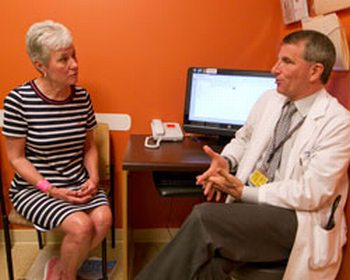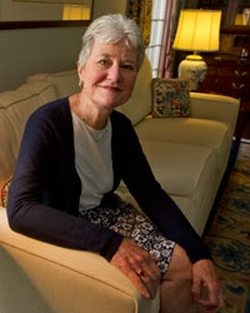Stanford Opens New Brain Tumor Center
Stanford Opens New Brain Tumor Center
Collaboration, expertise provides most advanced care available
A few hours after Marjorie Paulsen learned that a tumor was growing in her brain, she told her husband she didn’t want to go to sleep that night. “I’m afraid I won’t wake up,” she said.

- Marjorie Paulsen (left) discusses treatment for her brain tumor with Lawrence Recht, MD (right), one of the physicians at the Stanford Brain Tumor Center, which opens today.
Paulsen knew nothing about how that tumor might be treated. She was reacting with that special fear that emerges when something so central to life is threatened. Almost as much as Paulsen needed direct treatment of her tumor, she needed understanding and warmth.
Today, Stanford Hospital & Clinics inaugurates its new Brain Tumor Center, framing its considerable corps of top-notch specialists into a treatment team driven by expertise, experience and compassion.
The Stanford Brain Tumor Center will not have its own building; it does reflect a collaboration-shaped structure designed to streamline how patients receive care. The goal, said Center Director Griff Harsh, MD, “is to give patients the highest quality of care, delivered with a matching level of efficiency.”
Having brain cancer is one of the most difficult medical conditions to treat, said Gordon Li, MD, one of two physicians hired to augment the hospital’s already-robust group of brain tumor specialists. “The brain is a lot more mysterious than the heart or lungs, and it’s who we are, what defines us. That raises the impact of a brain tumor diagnosis.”
“Using the word center implies a higher level of organization than just a few doctors running around,” said Stanford neurosurgeon Steven D. Chang, MD, Director of Stanford’s Neuromolecular Innovation Program, and a Center team physician. “Somewhere else you can patch together a surgeon, a radiation oncologist, etc., but are you going to get them in a room together to talk about you? Our patients can feel that not only are they being seen in a world-class medical center, but that they’re getting the expertise of all our physicians.”
That expertise translates into the most advanced care available. “If something cutting edge is going to be done, it’s likely to be done here at Stanford,” said Lawrence Recht, MD, Director of Adult Neuro-Oncology, one of the physicians at the new Stanford Brain Tumor Center. Tumors that originate in the brain are still rare, compared to many other health conditions, he said, “so it makes a difference if you are treated at a place where they know what they’re doing.” We have virtually every possible discipline and specialty represented here, with a large body of accumulated experience. That can make a big difference in results for patients.”
At the new Center, the average first visit will include time with a doctor, time with nurses and sometimes time with social work and other support services, said Seema Nagpal, MD, another physician recently added to the Stanford Brain Tumor Center team. “We really want to hear what our patients are feeling and we take the time to do that thoroughly.”
Another element in the Center’s care will be a group of nurses with special certification in neurological care and social workers experienced in the needs particular to tumor patients and their families, including resources in neuropsychology, rehabilitation and counseling. “Patients need someone to care about them all through the process,” Nagpal said.
At Stanford, in addition to consultations between physicians, an interdisciplinary brain tumor board meets weekly to review and discuss patient treatment plans. More than 20 specialist physicians and nurses in neuropathology, imaging, neurosurgeons, neurologists and neuro-oncologists usually attend.
At Stanford, Recht said, “We have a very strong group identity. We get along and we meet a lot. We really work well together; we respect each other’s expertise and we usually make our decisions by consensus.”

- “From day one, the team care at Stanford has been so wonderful,” said Marjorie Paulsen, a patient at Stanford’s new Brain Tumor Center. “The level of care has been off the chart.”
The Center will also connect patients directly with clinical trials and research at Stanford, where investigations include brain cancer’s cellular biology, cell markers for early tumor detection and genomic structure.
Harsh has practiced neurosurgery for more than 25 years, learning and appreciating new minimally invasive brain tumor removal, new imaging technology to guide his surgical path and ongoing collaboration with his peers to build on the expertise of each. “I do a majority of my surgeries with another colleague,” Harsh said. “We are mutually enhancing in our ways of approach and thought.”
That new image technology he can now employ is as much about combining the available in new ways as about inventing new devices. Stanford’s Josef Parvizi, MD, PhD, another member of the Brain Tumor Center group, is a neurologist focused on human brain mapping. He has been part of Paulsen’s care team. He and his research team combine the tools of functional MRI and electrophysiological recordings with grids and strips of electrodes overlying the tumor area. The team electrically stimulates the cortex near the tumor area to build a map that enables surgeons to operate within the curved, compact canyons of the brain knowing far more specifically what can be taken and what cannot. With a multidisciplinary team combining standard tools to expand the view of brain activity, “We have gone beyond the conventional,” Parvizi said.
Even before the Stanford Brain Tumor Center was officially open, patients like Paulsen were receiving the kind of collaborative, advanced and full spectrum care the Center now offers.
In 2003, a Stanford surgeon removed what proved to be a malignant tumor from her brain, ending the seizures and the uncontrolled arm movement that were her first symptoms. “My hand would rise up in the air and move on its own, like the hand on ‘The Addams Family,’” she said, recalling that popular television show. She was a flight attendant for United Airlines, and would find, to her dismay, that that would sometimes happen as she would be holding a tray of coffee.
At every step of the way, her care included a neuro-oncologist, a neurosurgeon and a seizure specialist contributing special knowledge blended to coordinate Paulsen’s treatment from imaging, surgery, chemotherapy and seizure medications. “From day one, the team care at Stanford has been so wonderful. The level of care has been off the chart,” Paulsen said. “I’ll never forget the day I found out my tumor was malignant. That set me back a bit, but Lynn Adler, the nurse coordinator, said, ‘We have a plan,’ and she was so positive I thought, ‘Okay, I’ll go along with that.’ ”
After the surgery, she was treated with a drug that damages the DNA of tumor cells, stopping their growth. She was symptom free for almost seven years, when an MRI showed her tumor was getting bigger. This February, Harsh removed the growth and Paulsen is again free of symptoms.
When the tumor came back, she said, “Dr. Recht said, ‘We’ll deal with it’ and Dr. Harsh said, ‘We’ll go get it again,’ like taking a wart off my fingers. It was all done with such ‘We can do this’ that I thought, ‘Yes, we can!’ ”
About Stanford Hospital & Clinics
Stanford Hospital & Clinics is known worldwide for advanced treatment of complex disorders in areas such as cardiovascular care, cancer treatment, neurosciences, surgery, and organ transplants.
It is currently ranked No. 17 on the U.S. News & World Report’s “America’s Best Hospitals” list and No. 1 in the San Jose Metropolitan area.
Stanford Hospital & Clinics is internationally recognized for translating medical breakthroughs into the care of patients.
The Stanford University Medical Center is comprised of three world renowned institutions: Stanford Hospital & Clinics, the Stanford University School of Medicine, the oldest medical school in the Western United States, and Lucile Packard Children’s Hospital, an adjacent pediatric teaching hospital providing general acute and tertiary care.
About Stanford Brain Tumor Center
The Stanford Brain Tumor Center – Pioneers In The Treatment Of Brain And Spinal Tumors
The Stanford Brain Tumor Center is located inside our nationally recognized Stanford Cancer Center, a warm and welcoming facility that unites clinicians, researchers and health care professionals in a nurturing environment. Whether you arrive here as an emergency patient in our Tier 1 Emergency Department or make an appointment at the Center based on the advice of your primary care physician, you will benefit equally from all that our outstanding program in brain tumor diagnosis and treatment has to offer.
Collaborative team-based care for each patient
> Nationally recognized experts working together in an integrated program
> Weekly multi-specialty brain and spine tumor board where highly experienced physicians collaborate on the most challenging clinical dilemmas
> Advanced neuro-certified nursing care and rehabilitation teams
Superior diagnostic capabilities and advanced treatment options
> CT/PET, MRI, fMRI and intraoperative brain navigation
> Sophisticated radiation oncology devices including Cyberknife and TrueBeam for pinpoint accuracy of radiation treatment
> New radiologic tracers for detection of both early and advanced disease
> Expert Neuro-radiologists and coordination with ENT surgeons and neuro-endocrinologists
> Access to the latest clinical trials, radiation protocols, neurosurgical techniques and immunotherapy advancements
Extensive support services
> Guest service professionals to help navigate and manage treatment options
> Multiple support groups to help with specific cancer experiences
> Complementary healing programs such as meditation and acupuncture
> Survivorship program for patients and their family members
Successful treatment of brain tumors leads to a longer and better quality of life. At the Stanford Brain Tumor Center, thr physicians are at the forefront of new and successful brain tumor diagnoses and treatment services including new chemotherapy and immunotherapy protocols, new shorter course radiation treatments, advanced clinical trials, state of the art neurosurgery procedures featuring one of the highest ranked radiosurgery programs in the world, and post-operative neuro-specialized care.

* The above story is adapted from materials provided by Stanford University School of Medicine
________________________________________________________________
![]()

![]()



















